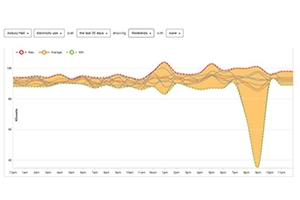Environment
You Need To Measure To Manage Submetering offers detailed information on how energy is being used

In its ongoing efforts to help control increasing energy costs while reducing environmental impacts, American University’s Energy & Engineering team incorporates submetering to its practices.
Submetering is the measurement of energy use in buildings, systems, and equipment to allow for a better understanding of how, when, and where energy is consumed. Energy Conservation and Efficiency Manager Juan Allen explained, “Submetering serves as a GPS for locating energy and water-savings opportunities.”
Submetering buildings on campus can make a substantial difference in utility costs, carbon footprint management, and overall energy practices. In fact, the U.S. Environmental Protection Agency (EPA) estimates that metering can help drive an average savings of 5 – 10 percent on utility bills.
With a campus-wide total of 57 utility meters that gauge electricity, water, natural gas, and thermal consumption and some meters serving multiple buildings, targeting facilities that waste energy becomes challenging. To obtain more detailed energy usage information, the E&E team installed electric submeters throughout campus. Since 40 percent of energy consumed and greenhouse gas emissions comes from buildings, targeting energy usage in buildings is a best energy management practice.
Submeters provide the detailed data and trending necessary for AU’s energy analysts, engineers, and management to:
- Benchmark campus buildings’ energy use against national databases;
- Measure results of energy conservation measures and projects;
- Identify equipment running unnecessarily in unoccupied buildings and during “peak rate” periods;
- Identify demand peaks, allowing Facilities Management to make necessary adjustments to better manage electricity usage and reduce peak-demand cost;
- Identify discrepancies with utility bills by comparing data;
- Detect system failures quickly; and
- Identify and prioritize opportunities for energy projects
By analyzing data and energy usage collected from submeters, the E&E team can see in small intervals when an individual building’s systems or equipment are using unusually high amounts of energy. Submetering makes it easier to figure out what is consuming the most energy and to see abnormal peaks in usage. It allows for the identification of equipment or systems that need to be repaired, maintained, or replaced. Energy projects also can be better prioritized based on which buildings are in higher need of upgrades, rather than using traditional meters which capture the entire campus’ usage.
Initially, the E&E team only used submeters to monitor electrical usage. However since 2012, it has been expanded to include thermal (heating and cooling) energy usage as well. Closer scrutiny of energy usage resulted in the E&E team seeing further opportunities for savings. For example, heating and cooling systems now only operate at full capacity during times of actual building occupancy. During off-hours, on-campus systems now run at lower settings. For example, before the new programming, the McKinley Building consumed about 358 kilowatts between 2 and 7 a.m. when the building was not being used. Now, the building uses about 155 kilowatts during the same time frame. The amount of kilowatts used has been reduced by more 55 percent.
Through data collected from methods like submetering, the E&E has found additional ways to cut waste and emissions for the university’s Utility and Energy Master Plan. Future energy-saving projects and pilots are in the works to achieve AU’s goal of reducing energy consumption by one to two percent annually.